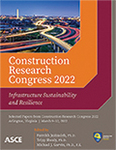Identifying and Assessing Critical Indicators of Resilience in Active Construction Sites
Publication: Construction Research Congress 2022
ABSTRACT
Construction safety culture in active construction sites is frequently challenged due to the uncertainties and unknowns associated with construction activities. The construction industry requires expertise from multifaceted professionals who differ widely in hazard identification, risk perception, and situational awareness. While the existing literature aims at the implementation measures of construction safety, it does not provide enough guidance on how the efficacy of these measures varies among the construction affiliates. Moreover, frequently occurring natural hazards and extreme weather events significantly impede construction activities as well as the proposed schedule. The empirical literature is inconclusive of how such events influence the risk perceptions of several stakeholders involved in construction activities. As such, the goal of the study is to develop a multi-disciplinary risk-perception framework based on a comprehensive set of hazards in contrasting scenarios (i.e., regular vs. extreme weather). In particular, the study contributes by (1) identifying the knowledge gaps in the existing literature related to construction safety practices and risk perception; (2) designing and conducting an extensive survey involving diverse scenarios related to construction activities (i.e., sub-structural, super-structural, etc.), types of hazards (i.e., tipping, fall, lifting, excavation, etc.), and weather conditions among others; (3) apprehending risk observations of construction practitioners, researchers, and experts; and (4) developing a unified construction risk spectrum to enhance construction site resilience. The findings of this study could shed new light on advancing the resilience capacity of active construction sites that can be observed in practice.
Get full access to this article
View all available purchase options and get full access to this chapter.
REFERENCES
Ahmed, M. A., et al. (2020) ‘Social Media Communication Patterns of Construction Industry in Major Disasters.’, in Construction Research Congress-2020.
Carter, G., and Smith, S. D. (2006) ‘Safety Hazard Identification on Construction Projects’, Journal of Construction Engineering and Management, 132(2), pp. 197–205. doi: https://doi.org/10.1061/(asce)0733-9364(2006)132:2(197).
Chmutina, K., and Bosher, L. (2014) ‘Construction in Barbados: Keeping natural hazards in mind?’, Disaster Prevention and Management: An International Journal, 23(2), pp. 175–196. doi: https://doi.org/10.1108/DPM-07-2013-0111.
Fang, D., Zhao, C., and Zhang, M. (2016) ‘A Cognitive Model of Construction Workers’ Unsafe Behaviors’, Journal of Construction Engineering and Management, 142(9), p. 04016039. doi: https://doi.org/10.1061/(asce)co.1943-7862.0001118.
Franco-Duran, D. M., and Mejia A. G. (2016) ‘Construction Research Congress 2016 2039’, PROCEEDINGS Construction Research Congress 2016, pp. 2039–2049. doi: https://doi.org/10.1061/9780784479827.203.
Gambatese, J., and Hinze, J. (2002) ‘Addressing construction worker safety in the design phase’, The Organization and Management of Construction: Shaping Theory and Practice: Volume Two: Managing the Construction Project and Managing Risk, pp. 871–880. doi: https://doi.org/10.4324/9780203477090.
Goldenhar, L. M., Williams, L. J., and Swanson, N. G. (2003) ‘Modelling relationships between job stressors and injury and near-miss outcomes for construction labourers’, Work and Stress, 17(3), pp. 218–240. doi: https://doi.org/10.1080/02678370310001616144.
Hamid, A. R. A., Yusof, W. Z. W., and Singh, B. S. B. J. (2003) ‘Hazards At Construction Sites’, Proceedings of the 5th Asia-Pacific Structural Engineering and Construction Conference (APSEC 2003) 26, 16(3), pp. 166–172. doi: https://doi.org/10.1159/000220724.
Jannadi, M. O. (1996) ‘Factors affecting the safety of the construction industry: A questionnaire including 19 factors that affect construction safety was mailed to the top 200 construction contractors in the UK. Safety officers and workers were asked to indicate how effective ’, Building Research and Information, 24(2), pp. 108–112. doi: https://doi.org/10.1080/09613219608727510.
Khan, N., et al. (2019) ‘Excavation Safety Modeling Approach Using BIM and VPL’, Advances in Civil Engineering, 2019. doi: https://doi.org/10.1155/2019/1515808.
Mojumder, M. N. H., Ahmed, M. A., and Sadri, A. M. (2021) ‘Identifying Ridesharing Risk, Response and Challenges in the Emergence of Novel Coronavirus (COVID-19) using Interactions in Uber Drivers Forum’, Frontiers in Built Environment, 7, p. 4. https://doi.org/10.3389/FBUIL.2021.619283.
Mojumder, M. N. H., and Sadri, A. M. (2021) ‘Exploring the Properties and Growth of Student Interaction Networks on Twitter : Insights on STEM Learning and Engagement Exploring the Properties and Growth of Student Interaction Networks on Twitter ’:, in.
Naoum, S. G., et al. (2020) ‘Gender in the Construction Industry : Literature Review and Comparative Survey of Men ’ s and Women ’ s Perceptions in UK Construction Consultancies’, 36(2). doi: https://doi.org/10.1061/(ASCE)ME.1943-5479.0000731.
Rusho, M. A. (2021) AGENT-BASED MODELING OF NEAR MISS INCIDENTS BY INTEGRATING CONSTRUCTION SITE DYNAMICS WITH ENRICHED WORKER BEHAVIOR. Florida International University.
Sawacha, E., Naoum, S., and Fong, D. (1999) ‘Factors affecting safety performance on construction sites’, International Journal of Project Management, 17(5), pp. 309–315. doi: https://doi.org/10.1016/S0263-7863(98)00042-8.
Schneider, S., and Susi, P. (1994) ‘Ergonomics and construction: A review of potential hazards in new construction’, American Industrial Hygiene Association Journal, 55(7), pp. 635–649. doi: https://doi.org/10.1080/15428119491018727.
Shen, X., and Marks, E. (2016) ‘Near-Miss Information Visualization Tool in BIM for Construction Safety’, Journal of Construction Engineering and Management, 142(4), p. 4015100. doi: https://doi.org/10.1061/(asce)co.1943-7862.0001100.
Zhang, M., and Fang, D. (2013) ‘Construction Management and Economics A cognitive analysis of why Chinese scaffolders do not use safety harnesses in construction A cognitive analysis of why Chinese scaffolders do not use safety harnesses in construction’, (April 2015), pp. 37–41. doi: https://doi.org/10.1080/01446193.2013.764000.
Information & Authors
Information
Published In
History
Published online: Mar 7, 2022
Authors
Metrics & Citations
Metrics
Citations
Download citation
If you have the appropriate software installed, you can download article citation data to the citation manager of your choice. Simply select your manager software from the list below and click Download.
